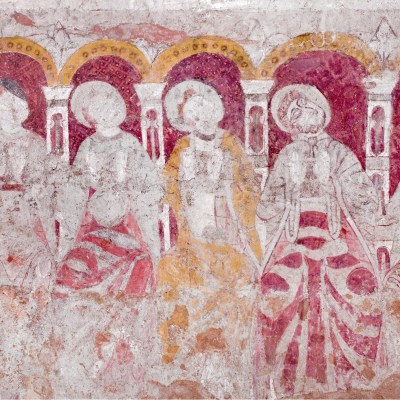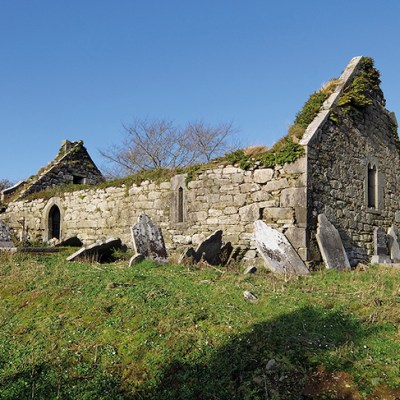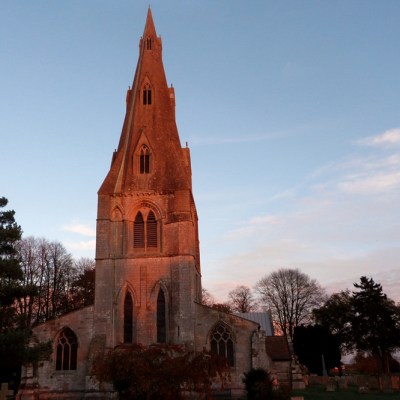On the wall of a shabby-looking church in Oldham, Greater Manchester, there is – for the moment, at least – a mosaic of the Crucifixion executed in a Byzantine style. Christ hangs on the cross against the backdrop of a shimmering golden mandorla. Today, only this central element of the mural completed in 1955 by the Hungarian-Jewish émigré George Mayer-Marton is visible. It was once flanked by depictions of an etiolated Mary and the apostle John, since covered over in white paint. The background, now also obscured, gave away something of the mural’s provenance: a fragmented, cubist explosion of abstracted land- or cityscapes in brooding blue and grey, a Braque-inflected vision touched by hints of Klimt and perhaps even Chagall.
Mayer-Marton’s epic work is found in the small Church of the Holy Rosary in Oldham, built in the 1950s, and now – with its congregation collapsed and no priests to minister to it – closed. A campaign is running with the support of Save Britain’s Heritage to have the mural listed, in an attempt to protect it from the threats of vandalism, theft or redevelopment of the unused church. This is not the first such campaign: in 1989, another of the artist’s works was transferred to Liverpool Metropolitan Cathedral, this one depicting the cascade of tongues of fire on the Pentecost, saved from the now-demolished Church of the Holy Ghost in Netherton. Together, the works shine a light on a remarkable moment in British art, when the scene was inundated with talent from the Central European exodus of the 1930s, and the institution that acted as patron, midwife and saviour to so many of the artists was the resurgent Catholic Church.
Many of the greatest names in 20th-century British painting were central Europeans and Germans, mostly of Jewish descent: Lucian Freud, Frank Auerbach, Leon Kossoff (not to mention the entire art-critical establishment, from Pevsner to Gombrich). But there was another stratum of less well-known figures who had nevertheless been well established in their homelands before the rise of the Nazis and who found themselves in Britain scraping around for work, often in the big cities outside London.
George Mayer-Marton’s mosaic and fresco before the latter was painted over. © The Estate of George Mayer-Marton

Mayer-Marton was just such an artist. Born in Gyor in western Hungary in 1897, he studied fine art and enjoyed a successful career in Vienna in the 1920s and ’30s, becoming respected figure in the interwar art scene, before fleeing to London after the Anschluss in 1938. His luck didn’t improve. In 1940 during the Blitz his home and studio in St John’s Wood were hit by an incendiary bomb and all his work was destroyed along with almost all his other possessions. His wife Grete never recovered from this trauma (she died in 1952) and he later learned that his other family members had perished in the Holocaust. Mayer-Marton didn’t paint again until long after the war was over and then slowly rebuilt a reputation, as an intriguing and intense artist. In 1952 he began teaching at the Liverpool College of Art, where Stuart Sutcliffe and John Lennon passed through his art-history classes, which gave a far more Eurocentric view than was fashionable in England at the time. Meanwhile, through his work for schools, estates, community halls and churches, he almost single-handedly revived the art of mosaics in modern Britain. He died in 1960, the year Sutcliffe and Lennon formed the Beatles, and his life was celebrated in a well-regarded memorial exhibition at the Walker Art Gallery. His experiences of pain and deracination were always visible in the work – paintings and watercolours as well as mosaics – which was pervaded by a sense of tragedy and fragmentation. There was some hope to be found, too, particularly in his vivid paintings of the British landscape he came to adore.
Mayer-Marton’s career had greatly benefited from the wave of post-war municipal rebuilding and the revival of Catholic church-building (notably in cities with big Irish populations including Liverpool, Manchester, Glasgow and London) in the wake of Vatican II and in the radical mould of the modern churches commissioned by Father Couturier, who prioritised aesthetics over the religious affiliations of the architects and artists he hired. Mayer-Morton was not alone. Other figures including Hans Feibusch, Adam Kossowski, Ernst Blensdorf, Henryk Gotlib and the remarkable Ervin Bossanyi (one of the finest 20th-century artists in stained glass) – all refugees – enlivened and enriched British art with a richness of styles, media and approaches to abstraction and installation that shook up establishment complacency and pocked churches and public buildings with often dazzling artworks.
With municipal cuts and the decline in attendance and revenue for the Catholic and Anglican churches, those works, once so optimistically modern, are in peril. We must perhaps accept that buildings often outlive their need but, while it’s always a shame to lose a modernist church, there is no need to lose Mayer-Marton’s work with it. It’s a survival from a significant moment, in which the arrival of ideas and impulses from the modernist heartlands transformed British art. The innovations of émigré artists were soon dispersed across the country – often in the unlikeliest of places.



